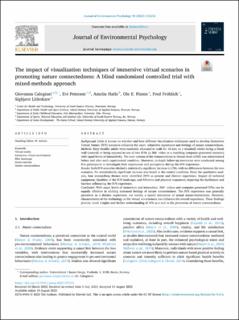| dc.contributor.author | Calogiuri, Giovanna | |
| dc.contributor.author | Petersen, Evi | |
| dc.contributor.author | Haile, Amelia | |
| dc.contributor.author | Flaten, Ole E. | |
| dc.contributor.author | Fröhlich, Fred | |
| dc.contributor.author | Litleskare, Sigbjørn | |
| dc.date.accessioned | 2024-02-07T11:15:42Z | |
| dc.date.available | 2024-02-07T11:15:42Z | |
| dc.date.created | 2023-08-21T17:35:25Z | |
| dc.date.issued | 2023 | |
| dc.identifier.issn | 0272-4944 | |
| dc.identifier.uri | https://hdl.handle.net/11250/3116137 | |
| dc.description.abstract | Background Little is known on whether and how different visualization techniques used to develop Immersive Virtual Nature (IVN) scenarios influence the users' subjective experience and feelings of nature connectedness. Methods Sixty healthy adults were randomly allocated to walk for 10 min on a treadmill whilst facing a blank wall (control) or being exposed to one of two IVNs (a 360° video or a matching computer-generated scenario) with equal levels of interactivity. The state version of the Connectedness to Nature Scale (CNS) was administered before and after each experimental condition. Moreover, in-depth follow-up interviews were conducted among five participants to investigate their experiences and perceptions during the IVN experience. Results Both IVN scenarios elicited a statistically significant increase in CNS, with no differences between the two scenarios. No statististically significant increase was found in the control condition. From the qualitative analysis, four overarching themes were identified (IVN as present and distinct experience, Impact of technical equipment, Qualities of the IVN landscape, and Affective and physical responses), depicting the facilitators and barriers influencing the IVN experience. Conclusion With equal levels of immersion and interaction, 360° videos and computer-generated IVNs can be equally effective in eliciting increased feelings of nature connectedness. The IVN experience was generally perceived as a distinct experience, not merely a (poor) simulation of actual nature-interactions. However, characteristics of the technology or the virtual environment can influence the overall experience. These findings provide novel insights and further understanding of IVN as a tool in the promotion of nature connectedness. | en_US |
| dc.language.iso | eng | en_US |
| dc.relation.uri | https://www.sciencedirect.com/science/article/pii/S0272494423001500 | |
| dc.rights | Navngivelse 4.0 Internasjonal | * |
| dc.rights.uri | http://creativecommons.org/licenses/by/4.0/deed.no | * |
| dc.title | The impact of visualization techniques of immersive virtual scenarios in promoting nature connectedness: A blind randomized controlled trial with mixed-methods approach | en_US |
| dc.type | Peer reviewed | en_US |
| dc.type | Journal article | en_US |
| dc.description.version | publishedVersion | en_US |
| cristin.ispublished | true | |
| cristin.fulltext | original | |
| cristin.qualitycode | 2 | |
| dc.identifier.doi | 10.1016/j.jenvp.2023.102102 | |
| dc.identifier.cristin | 2168567 | |
| dc.source.journal | Journal of Environmental Psychology | en_US |
| dc.source.volume | 90 | en_US |
| dc.source.issue | 102102 | en_US |

